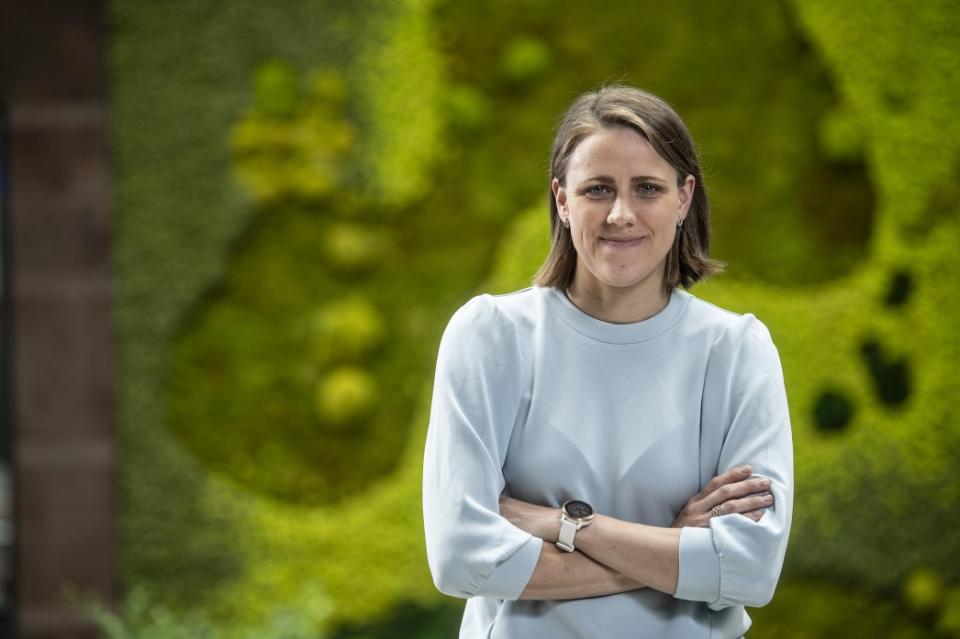
Smart investing in sustainable real estate
The real estate world is changing dramatically. What once seemed futuristic is now a reality: green ‘15-minute cities’, circular healthcare villages, hybrid workplaces and energy-efficient data centres ... they are springing up like mushrooms. Discover how ESG principles (Economic, Social, Governance), real estate, mobility and responsible investing are coming together to form a new reality.
Green cities recapture public space for their residents. This benefits the environment, social cohesion and the economy alike; in other words, the full ESG picture. It’s an interesting mix for investors who value responsible investing.
Sabrina Reynen, Portfolio Manager at KBC Asset Management
CITIES: from 15-minute cities to vertical jungles

‘Urban transformation is in full swing,’ Sabrina Reynen, Portfolio Manager at KBC Asset Management, assures us. ‘Cities like Paris, Barcelona and Melbourne are fully committed to the concept of the 15-minute city, in which residents can access all their daily needs - work, school, shopping, health care, leisure - within 15 minutes on foot or by bike. Reconfigured streets, greener squares and car-free zones are just some of the many projects being carried out in these cities. The public spaces in these cities are being reclaimed for their residents. This model not only promotes quality of life and social cohesion, but also reduces traffic pressure, air pollution and CO₂ emissions.’
In Utrecht, the Merwede district is being developed as a car-free, circular city district with 12 000 residents. Mobility hubs, shared transport and green plazas are also central elements here. The Aspern Seestadt project in Vienna, is another model of smart city development, with a mix of living, working and recreation, supported by digital infrastructure and renewable energy. Another example is Bremen, in Germany,where a completely car-free neighbourhood has been created, smart mobility solutions such as shared scooters, cargo bikes and an integrated public transport network.
‘There are also a number of initiatives in Belgium,’ says Reynen. ‘The Vaartkom district in the town of Leuven is being redeveloped into a vibrant, mixed-use urban neighbourhood with a focus on water management, mobility and biodiversity. Ghent is experimenting with circular urban development in the Oude Dokken district, where living, working and recreation go hand in hand. In Brussels, the Tour & Taxis site, a historic local heritage site, has been redeveloped into an inclusive and sustainable multifunctional residential neighbourhood.’
Cities that are committed to becoming greener are not only more liveable, they are also economically attractive.
Sabrina Reynen, Portfolio Manager at KBC Asset Management
‘Urban greening’ plays a key role in this transformation. That means things like green roofs, vertical gardens, urban forests and permeable streets. In Singapore, buildings such as the Marina One complex have been designed as vertical jungles, promoting biodiversity and improving the micro-climate. In Milan, the ‘Bosco Verticale’ project has transformed two residential towers into a vertical forest with more than 900 trees and 20 000 plants. These kinds of projects improve air quality, reduce heat stress and increase the well-being of residents.
‘These cities are not only more liveable, they are also economically attractive. Properties in these zones have higher occupancy rates, lower operating costs and greater capital appreciation. Integrating ESG principles into urban development is no longer a luxury, but a necessity,’ says Reynen.
BUILDINGS: from data centres to healthcare villages
Buildings account for nearly 40 per cent of global carbon emissions. The aim is to reduce CO₂ emissions from residential real estate from 50 kg/m² in 2021 to 7 kg/m² in 2050. ‘That means the transition to smart, green buildings is crucial,’ says Reynen. ‘These buildings are equipped with sensors, AI-driven energy management platforms and built using circular materials. They adapt to different uses, optimise energy consumption and increase the comfort of residents and employees.’
A leading example is the Edge Olympic building in Amsterdam, which collects real-time data on occupancy, air quality and energy consumption via a digital platform. Using an app, users can personalise their workplace by adjusting the temperature, light and air quality. As well as being energy-positive, the building is designed for hybrid working, with flexible work zones and shared facilities. There is a similar example in Brussels. There, Befimmo's Quatuor building has been awarded a BREEAM ‘Outstanding’ certificate.
Data centres are the new 'place to be' in real estate investment. They are the backbone of our digital society.
Sabrina Reynen, Portfolio Manager at KBC Asset Management

‘Data centres, too, which are often energy-intensive, are becoming greener. They are being integrated into urban networks, with a focus on energy-efficiency and circular building materials,’ says Reynen. In Sweden, the EcoDataCentre runs entirely on renewable energy and reuses waste heat for district heating. Microsoft is even experimenting with underwater data centres to optimise cooling and reduce ecological impact. ‘Data centres have become the new 'place to be' in the real estate world. They are the backbone of our digital society. Companies like Equinix and Digital Realty Trust not only provide power and cooling, but also hyper-secure infrastructure for AI-driven data storage,’ adds Reynen.
‘Logistics centres are evolving into smart hubs. Prologis is building warehouses in the United States for Amazon, FedEx and Walmart where robots autonomously pick orders in the dark - energy-saving and efficient. These centres have new energy targets. Their roofs are covered with solar panels, providing their tenants with renewable energy and reducing their environmental footprint. Something for investors to bear in mind,’ notes Reynen.
Real estate for the care sector is another segment where innovative housing forms are emerging. They have long existed in the US, but ‘retirement villages’ with luxury amenities such as swimming pools, golf courses and restaurants are also beginning to appear in the UK. These villages combine comfort with care support and have long waiting lists. An entire retirement village also recently opened in Denmark, where older people live independently in a green, social environment with customised care. In Japan, smart sensors are being deployed in housing to detect falls and organise care proactively. The supply of senior housing in Belgium is still limited, but the ageing population and shortage of care staff make this an interesting market.
‘Student housing is also a growing sector, Reynen believes. ‘REITs (Real Estate Investment Trusts) such as Xior and Unite are responding to this by offering modern, well-equipped accommodation with a focus on social wellbeing. Demand exceeds supply, leading to stable rental income and value appreciation.’
A notable newcomer is the cooperative housing model that combines ESG principles with community living. Residents join forces to invest in sustainable housing projects, share facilities and decide collectively on management and renovation. This model is gaining ground in cities like Ghent, Berlin and Copenhagen, and fits in perfectly with the trend towards inclusive, affordable and sustainable housing.
INFRASTRUCTURE AND MOBILITY: from smart lighting to heated cycle paths
Energy-positive bridges, heated cycle paths, urban mining, ... these are not really terms that are heard in everyday common parlance. And yet it's these kinds of emerging innovations that investors should keep an eye out for.
Sabrina Reynen, Portfolio Manager at KBC Asset Management
‘Smart cities require smart infrastructure. Think of energy-positive bridges, smart lighting, electric vehicle charging infrastructure and digital traffic control. In Copenhagen, cycle paths are heated using waste heat to keep them safe, even in winter,’ says Reynen as an example.
Mobility is moving towards shared, electric and autonomous transport. In Hamburg, Siemens Mobility is testing a smart traffic system that integrates self-driving shuttles with public transport.
‘Water infrastructure is also getting smarter,’ says Reynen. ‘In Rotterdam, smart pumps and water buffers ensure a climate-proof city that can handle heavy rainfall. Antwerp is experimenting with circular sewage systems that treat and reuse wastewater locally.’
‘Materials are used in a circular way. In London, a bridge has been built out of recycled plastic. In Ghent, urban mining is used, in which materials from demolished buildings are reused for new-build projects. This reduces the environmental footprint and boosts local employment,’ says Reynen, concluding the long list of examples.
RESPONSIBLE INVESTING: building block of sustainability

The transition to smart, green cities requires huge investments. ‘This is where ESG integration and responsible investing come in,’ says Reynen, drawing on her expertise. ‘REITs play a key role by mobilising capital for sustainable real estate projects. They are no longer mere real estate funds, but vehicles for the ESG transformation. They are committed to green renovations, solar energy, water conservation and WELL certification, an internationally recognised seal of approval that shows that a building has been designed and managed with a strong focus on health and well-being.’
‘Investors are increasingly looking at the GRESB score, which rates REITs on sustainability,’ Reynen observes. ‘More and more investors are choosing funds with high ESG ratings because they are not only socially responsible, but also financially robust.’
Prologis, the world's largest logistics REIT, is aiming for net-zero emissions and is planning to have nearly 1 gigawatt of solar capacity installed by the end of 2025. That's a lot, considering that a gigawatt can power about one million households. URW (Unibail-Rodamco-Westfield) focuses on circular urban development and is aiming for zero waste by the end of 2025.
Thematic investment funds actively invest in REITs that promote sustainability through green buildings, smart technologies and resilient infrastructure.
Institutional investors, such as pension funds and insurers, are also increasingly focusing on impact investing in real estate. They invest in projects that not only generate financial returns, but also contribute to climate goals, social inclusion and urban resilience.
REITs are the vehicles of ESG transformation. Those looking to invest responsibly will find powerful tools to make an impact with REITs and engaged thematic funds.
Sabrina Reynen, Portfolio Manager at KBC Asset Management
‘Smart, green cities are no longer a futuristic concept. They are the setting in which innovative buildings, infrastructure and mobility come together. From data centres to healthcare villages, logistics hubs to student housing - the building blocks are there. The challenge now lies in upscaling, cooperation and smart investments. Those looking to invest responsibly will find powerful tools to make an impact through REITs and engaged thematic funds,’ concludes Reynen.
Want to learn more about responsible investing?
The information contained in this publication is for information purposes only and should not be considered as investment advice.

